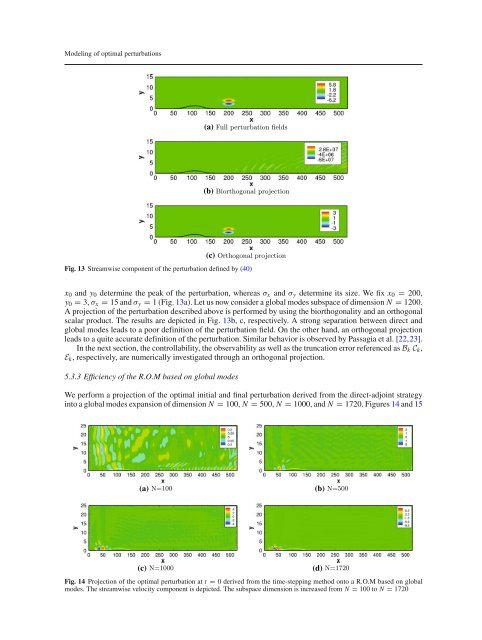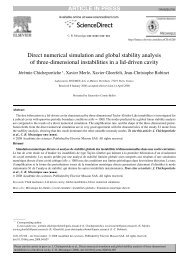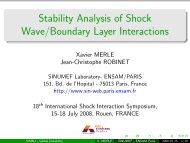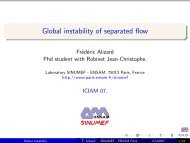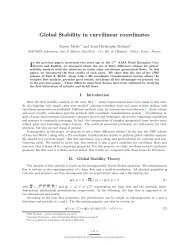Modeling of optimal perturbations in flat plate boundary ... - Ensam
Modeling of optimal perturbations in flat plate boundary ... - Ensam
Modeling of optimal perturbations in flat plate boundary ... - Ensam
You also want an ePaper? Increase the reach of your titles
YUMPU automatically turns print PDFs into web optimized ePapers that Google loves.
<strong>Model<strong>in</strong>g</strong> <strong>of</strong> <strong>optimal</strong> <strong>perturbations</strong>(a)(b)Fig. 13 Streamwise component <strong>of</strong> the perturbation def<strong>in</strong>ed by (40)(c)x 0 and y 0 determ<strong>in</strong>e the peak <strong>of</strong> the perturbation, whereas σ x and σ y determ<strong>in</strong>e its size. We fix x 0 = 200,y 0 = 3, σ x = 15 and σ y = 1(Fig.13a). Let us now consider a global modes subspace <strong>of</strong> dimension N = 1200.A projection <strong>of</strong> the perturbation described above is performed by us<strong>in</strong>g the biorthogonality and an orthogonalscalar product. The results are depicted <strong>in</strong> Fig. 13b, c, respectively. A strong separation between direct andglobal modes leads to a poor def<strong>in</strong>ition <strong>of</strong> the perturbation field. On the other hand, an orthogonal projectionleads to a quite accurate def<strong>in</strong>ition <strong>of</strong> the perturbation. Similar behavior is observed by Passagia et al. [22,23].In the next section, the controllability, the observability as well as the truncation error referenced as B k C k ,E k , respectively, are numerically <strong>in</strong>vestigated through an orthogonal projection.5.3.3 Efficiency <strong>of</strong> the R.O.M based on global modesWe perform a projection <strong>of</strong> the <strong>optimal</strong> <strong>in</strong>itial and f<strong>in</strong>al perturbation derived from the direct-adjo<strong>in</strong>t strategy<strong>in</strong>to a global modes expansion <strong>of</strong> dimension N = 100, N = 500, N = 1000, and N = 1720. Figures 14 and 15(a)(b)(c)Fig. 14 Projection <strong>of</strong> the <strong>optimal</strong> perturbation at t = 0 derived from the time-stepp<strong>in</strong>g method onto a R.O.M based on globalmodes. The streamwise velocity component is depicted. The subspace dimension is <strong>in</strong>creased from N = 100 to N = 1720(d)


